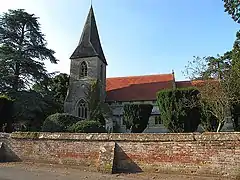Brightwalton
Brightwalton is a village and civil parish in the Berkshire Downs centred 7 miles (11 km) NNW of Newbury in West Berkshire.
| Brightwalton | |
|---|---|
| Village | |
 All Saints' parish church | |
 Brightwalton Location within Berkshire | |
| Area | 8.45 km2 (3.26 sq mi) |
| Population | 366 (2011 census)[1] |
| • Density | 43/km2 (110/sq mi) |
| OS grid reference | SU4279 |
| Civil parish |
|
| Unitary authority | |
| Ceremonial county | |
| Region | |
| Country | England |
| Sovereign state | United Kingdom |
| Post town | Newbury |
| Postcode district | RG20 |
| Dialling code | 01488 |
| Police | Thames Valley |
| Fire | Royal Berkshire |
| Ambulance | South Central |
| UK Parliament | |
| Website | Brightwalton Web Site |
Parish church
The Church of England parish church of All Saints existed by the time of the Domesday Book of 1086.[2] The building was demolished in 1863[2] and replaced by a Gothic Revival one designed by G E Street,[3] who was architect to the Diocese of Oxford. Street retained and re-used some 13th century Early English Gothic features from the original building.[2]
School
The parish has a Church of England primary school.[4] It too was designed by Street and built in 1863.[5]
Notable residents
In about 1715 the Savo(u)ry family moved to the village from nearby South Moreton. The Savorys were wheelwrights, but William Savory (1768–1824) from a third generation of the family, was apprenticed to David Jones, an apothecary in Newbury, Berkshire. Aged 20, Savory "walked the wards" of St Thomas' Hospital and Guy's Hospital in London. He learned surgery, physic (medicine) and midwifery from the leading practitioners of their day, including the surgeon Henry Cline and physician William Saunders. Some of his student notes and his commonplace book survive.[7] Savory became a member of the Company of Surgeons and initially practiced in Newbury. Following bankruptcy in 1795 he re-settled in Brightwalton, where he remained for the rest of his life, passing the mantle to his son, William Savory (1793–1856) who studied at the London Hospital in Whitechapel.[8]
Sir Samuel Eyre (1638–98), Justice of the King's Bench, lived in the parish, having inherited the manor of Brightwalton in 1694 through his wife Lady Martha Lucy. Their son Robert Eyre, also of Brightwalton, became Lord Chief Justice. [2]
The author Monica Dickens lived in the village in the last years of her life.[9] Prolific children's author Rosemary Hayes went to school locally.
Demography
| Output area | Homes owned outright | Owned with a loan | Socially rented | Privately rented | Other | km2 roads | km2 water | km2 domestic gardens | Usual residents | km2 |
|---|---|---|---|---|---|---|---|---|---|---|
| Civil parish | 44 | 52 | 19 | 20 | 7 | 0.076 | 0.001 | 0.132 | 366 | 8.45 |
References
- "Key Statistics: Dwellings; Quick Statistics: Population Density; Physical Environment: Land Use Survey 2005". Archived from the original on 11 February 2003. Retrieved 26 July 2010.
- Page & Ditchfield 1924, pp. 48–51
- Pevsner 1966, p. 101.
- Brightwalton CofE Primary School
- Pevsner 1966, p. 102.
- "Connect Service 101" (PDF). Newbury and District. January 2013. Archived from the original (pdf) on 19 August 2013. Retrieved 19 October 2014.
- "SAVORY, William (fl 1788-1789)". AIM25: Archives in London and the M25 area. 1998–2013.
- See Stuart Eagles "The life of William Savory, surgeon of Brightwalton" and "William Savory: Rise and Fall" in Berkshire Family Historian vol. 17, no. 4 (June 1994) and vol. 21, no. 1 (September 1997), and George C. Peachey, The life of William Savory, surgeon of Brightwalton (J.J. Keliher, 1903).
- "Latest wills", The Times page 14, 13 August 1993
Sources
- Page, W.H.; Ditchfield, P.H., eds. (1924). A History of the County of Berkshire. Victoria County History. Vol. 4. assisted by John Hautenville Cope. London: The St Katherine Press. pp. 48–51.
- Pevsner, Nikolaus (1966). The Buildings of England: Berkshire. Harmondsworth: Penguin Books. pp. 101–102.
External links
![]() Media related to Brightwalton at Wikimedia Commons
Media related to Brightwalton at Wikimedia Commons